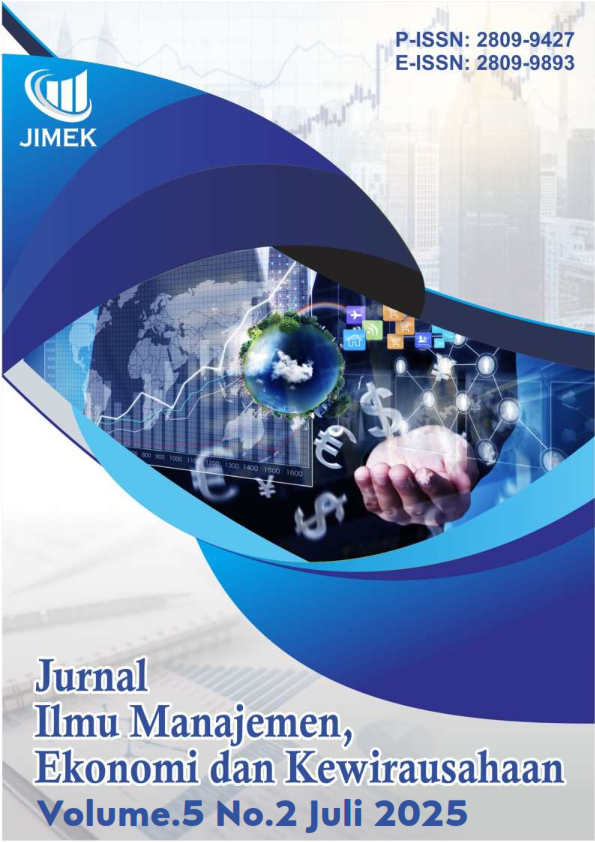Instrumen Keuangan Syariah Murabahah, Bai Istijrar dan Bai Ul-Wafa
DOI:
https://doi.org/10.55606/jimek.v5i2.5955Keywords:
Islamic Banking, Islamic Financial Instruments, Islamic Financing, MurabahahAbstract
This article examines murabahah as the most dominant financing instrument in Indonesian Islamic banking. The basic concept, legal basis, and various practices of murabahah that have developed are described through library research on classical fiqh works, DSN-MUI fatwas, and Bank Indonesia regulations. The results show that murabahah requires bank ownership of goods, fixed margins, price transparency, and a prohibition on recognizing late fees as income. Three models can be applied in the field: direct purchase by the bank, bank payment by direct delivery of goods to the customer, and the most common wakalah model. However, this model is shariah risky if the contract is made before the goods are legally owned by the bank. This article highlights the need for standardization of procedures to be consistent with muamalah fiqh while meeting contemporary regulatory requirements, and recommends further research on the harmonization of murabahah accounting between AAOIFI and IFRS. The dominance of murabahah covers around 60% of the financing portfolio.
References
Adha, S. I., Furqani, H., & Adnan, M. (2020). Konversi bank konvensional menjadi bank syariah di Indonesia. Journal of Sharia Economics, 1(1), 37–57.
Al-Zuḥaylī, W. (1985). Al-Fiqh al-Islāmī wa Adillatuh (Jld).
Amin, R. (2016). Dinamika penerapan murabahah dalam sistem perbankan syariah. Jurnal Perbankan Syariah, 1(1), 1–13.
Andriansyah, Y. (2010). Isu terkini industri perbankan dan keuangan Islam Asia Tenggara. La_Riba, 4(2), 267–271.
Ghozali, R. S., & M., S. (2018). Aplikasi akad murabahah pada lembaga keuangan syariah. Jurnal Masharif Al-Syariah: Jurnal Ekonomi dan Perbankan Syariah, 3(1).
Hakim, C. M. (2004). Problematika penerapan murabahah dalam bank syariah. Paper presented at Lokakarya Produk Murabahah, Balaikota Bogor, 26.
Hidayati, N., & Sarono, A. (2019). Pelaksanaan akad qardh sebagai akad tabarru. Notarius, 12(2), 931–947.
Iswanaji, C., Aziz, A., Rizki, M., Zulfkar, A. L., Romli, N. A., Saftri, D., Mahardika, S. G., Kurnia, R., Hasan, D. H., Nurhasanah, S., Nissa, I. K., Huda, M. W. S., Sugianto, S., Susanti, S., & Risya K, E. A. (2024). Perkembangan industri halal & penguatan lembaga keuangan syariah. CV. Adanu Abimata. https://books.google.co.id/books?hl=en&lr=&id=Eh0QEQAAQBAJ&oi=fnd&pg=PA5&dq=info:ZriSLHFViBgJ:scholar.google.com&ots=XpX7-GKCXr&sig=-SB392UQjPo8rjCPgUkT3d5cAuk&redir_esc=y#v=onepage&q&f=false
Lathif, A. A. (2013a). Konsep dan aplikasi akad murabahah pada perbankan syariah di Indonesia. AHKAM: Jurnal Ilmu Syariah, 12(2).
Lathif, A. A. (2013b). Konsep dan aplikasi akad murâbahah pada perbankan syariah di Indonesia. AHKAM: Jurnal Ilmu Syariah, 12(2), 69–78. https://doi.org/10.15408/ajis.v12i2.967
Mahomed, Z. (2020). Islamic finance instruments—Murabahah, Bai Istijrar and Bai ul-Wafa’. International Centre for Education in Islamic Finance.
Moosa, R. (2023). An overview of Islamic accounting: The Murabaha contract. Journal of Risk and Financial Management, 16(7). https://doi.org/10.3390/jrfm16070335
Nasional, M. U. I. D. S., & Indonesia, B. (2006). Himpunan fatwa Dewan Syari’ah Nasional (Vol. 1). Dewan Syariah Nasional, Majelis Ulama Indonesia dan Bank Indonesia.
Pasha, A. E., & Sugianto, S. (2024). The urgency of implementing sharia accounting in sharia financial institutions in the Indonesian context: Bibliometric analysis. Journal of Business, Finance, and Economics (JBFE), 5(2), 27–35. https://doi.org/10.32585/jbfe.v5i2.5685
Putra, P. A. A., Imaniyati, N. S., & Nurhasanah, N. (2021). Al-Murâbahah Li Al-Âmir bi Al-Syirâ: Studi pemikiran Yûsuf Al-Qaradhâwî dan relevansinya dengan fatwa DSN-MUI. Istinbath, 20(2), 262–295.
Saeed, A. (1966). A study of Riba and its contemporary interpretation. Koln.
Zuhra, S. A., & Sugianto, S. (2024). Peran pembiayaan industri halal di BMT: Sebuah kajian literatur tentang tantangan dan pengembangan. J-CEKI: Jurnal Cendekia Ilmiah, 4(1), 1961–1970. https://doi.org/10.56799/jceki.v4i1.5770
Downloads
Published
How to Cite
Issue
Section
License
Copyright (c) 2025 Jurnal Ilmu Manajemen, Ekonomi dan Kewirausahaan

This work is licensed under a Creative Commons Attribution-ShareAlike 4.0 International License.








